As government shutdowns have become more frequent in recent years, food stamp recipients have been in constant state of worry as each threat of shutdown looms. In this post, we will explain what happens to food stamps during government shutdowns and what can be expected during the next shutdown.
The food stamps Program in Numbers
There is a lot of misconceptions out there about the food stamps program. What most people don’t realize is how vital this program is to the American safety net for low-income families and individuals.
There are currently about 38.5 million people receiving snap benefits. There is the impression that food stamps beneficiaries are concentrated in certain parts of the country.
However, as the map below, shows, even though most of the states with a large percentage of people on food stamps are mostly in the south, there are also a high concentration of food stamps beneficiaries in other parts of the country. Here is a map showing the percentage of people on food stamps by state:
As you can see, the program is a vital part of the livelihood of many Americans. For example in Nevada, Illinois, New York, Pennsylvania, Tennessee, Florida and Georgia, 14% of the population is on food stamps.
In West Virginia and Louisiana, that number is 17% and 18% respectively. New Mexico has the highest number of people on food stamps, with 22% of the population receiving benefits.
With the government shutdown and potential for interruption in benefits, millions of people face the real threat of hunger.
Why Does the government shutdown?
There is a government shutdown when the President and Congress cannot agree on appropriation bills or continuing resolutions to fund federal government agencies and departments.
By law, Congress has to pass appropriation bills that the President has to sign into law to fund the government each federal fiscal year. The federal fiscal year is from October 1st to September 30th.
If the President and Congress cannot agree on the appropriation bills for that fiscal year, they can agree to pass continuing resolutions, which are bills that are passed to fund government agencies for a period of time, keeping spending at the same level as the previous fiscal year.
A government shutdown then happens when both sides are not able to agree on appropriation bills and cannot also agree on continuing resolutions.
Not all shutdowns affect the entire government. Sometimes, the funding dispute revolves around a few departments, so those departments are shutdown when funding runs out. That is called a partial shutdown
An example is the December 2018 shutdown, a partial shutdown involving select departments, including the Department of Homeland Security, whose funding dispute about the President’s request for funds for a border wall caused the government to shut down, affecting the other departments whose funding were also set to run out.
What Happens To Federal Workers During a Shutdown?
Each federal agency is required to prepare a contingency plan in case of a shutdown. In the plan, the agency must determine which workers are essential and which ones are not.
Essential workers are those whose jobs involve the safety of human life, the protection of property, or certain other types of work designated by their agencies as necessary to continue.
Workers deemed essential are required to work during a government shutdown, but are unpaid. They may be paid back wages after the Shutdown ends, but that is not guaranteed.
Federal employees deemed non-essential are sent home (on an unpaid furlough) during the shutdown. They are not to work while on furlough, even on a volunteer basis. They may be paid back wages after the shutdown. However, that is not guaranteed and it’s entirely up to Congress.
Food Stamps and the Government Shutdown
The food stamps program requires annual funding from Congress. Whether a government shutdown will affect food stamps benefits depends on when the last round of funding approved by Congress for the food stamps program is set to expire.
If the USDA funding is part of the unresolved funding issue that leads to the shutdown, then food stamps benefits are likely to be impacted by the shutdown, depending on how long the shutdown lasts.
Government Shutdown of December 2018
Here is how the December 2018 government shutdown happened:
The partial government shutdown began December 22 after President Trump and congressional Democrats could not agree on funding for the president’s long-sought southern border wall.
Nine out of 15 federal departments are closed, as well as dozens of agencies because their funding had run out. However, several funding bills were passed and signed, so about 75 percent of government services are unaffected by the shutdown.
A total of 800,000 federal government workers are affected by the partial shutdown.
Of those, more than 420,000 are working without pay, including agents from the FBI, Coast Guard, IRS and Department of Homeland Security.
Update on Food Stamps Benefits
According to the USDA, food stamp benefits for January 2019 will all be paid on time. There was uncertainty about benefit payments for February 2019 should the shutdown drag on.
The USDA had initially said that it could only pay 64% of February’s food stamps obligations with the current funding available.
However, the department then later said it had found a way to be able to pay all of February’s benefits but because of a technicality, February’s benefits will all be paid early, on or before January 20th.
If the shutdown drags on into March, there is no information on whether benefits will be paid since the USDA has no more emergency funding to draw from.



